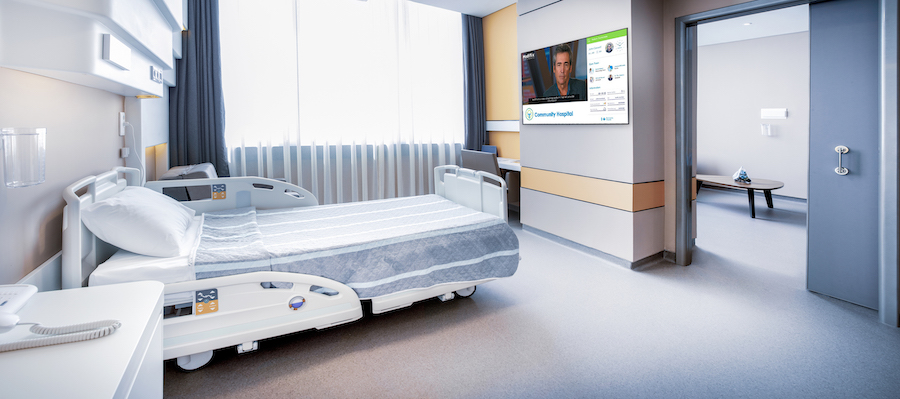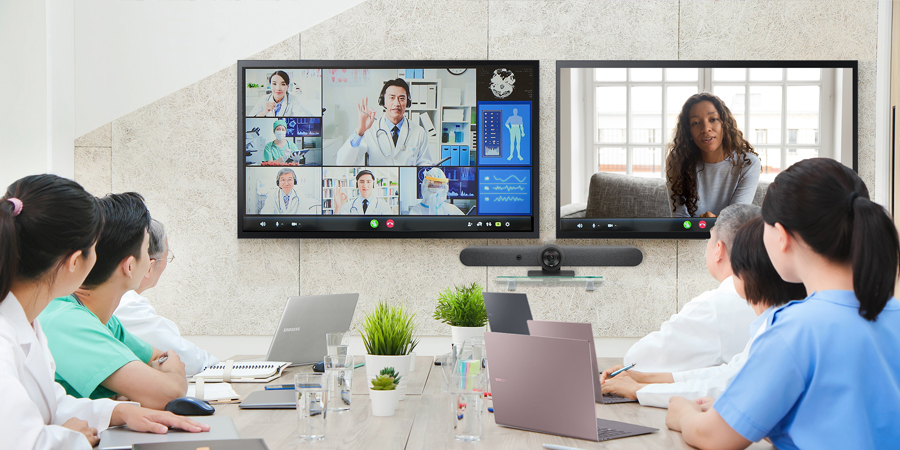Healthcare was inching toward a digital transformation well before the COVID-19 pandemic necessitated the shift. The global health crisis accelerated the pace of digital innovation, advancing virtual care, reinforcing the need for interoperability across platforms and locations, and demonstrating the power of remote collaboration.
Today, we benefit from that accelerated innovation. Perhaps the most visible example is the wider adoption of healthcare digital signage. Hospitals cannot advance digital transformation without digital signage that delivers the right messages to the right people at the right time. Clear, concise communication within and across teams is vital, as is communication with hospital visitors.
Digital signage affects the experience of everyone who steps foot in the hospital. It empowers clinicians by amplifying the flow of critical clinical information, engages guests with visual stories and information, and provides guidance for patients and their loved ones. Patient-centered, team-based care is facilitated by digital signage inside and outside the patient rooms.
In short, digital signage enables digital health. As I often tell my colleagues, “It’s the thing that gets you to the thing.” Of course, we have a long way to go, but it will be worth the effort. There are many benefits of digital signage in healthcare. By providing more efficient and patient-focused care, healthcare facilities cultivate a reputation for excellence, making it easier to attract patients, clinicians and staff.
Wayfinding: Guiding the patient journey
Getting lost is frustrating enough. Getting lost in a sprawling medical complex when you are worrying about a loved one, coping with an illness or facing surgery can be devastating. Yet health systems often fail to provide intuitive wayfinding systems for patients and visitors. The ensuing frustration, confusion and delays can set the tone for the entire patient experience, undermining patient satisfaction and even impairing care.
Digital signage solves this from the moment guests approach the facility. Outside signage directs guests to the right entrance, the right building and the right parking garage. Strategically placed kiosks for check-in and navigation can direct visitors to their desired destination via diagrams, directions and physician directories.
Optimize healthcare with digital signage
Once the guest enters the facility, digital signage helps continue the patient journey by providing direction and clarity as guests move through the campus. Touchscreen maps show patients and visitors where they are and where they need to go. This eases the journey for the patient and relieves the burden on staff members, who no longer have to assist lost guests.
Rethinking hospital patient whiteboards
Digital signage can make a measurable impact inside the patient’s room. Just think of the traditional dry-erase board, the standard for patient communication and notes. In theory, the board is updated each shift with the names of the patient’s care team members, and real-time information about medications, goals, dietary restrictions and estimated date of discharge. Too often, however, it’s out of date, inaccurate or simply illegible.
Hospital patient room digital whiteboards, in contrast, update automatically based on data from other integrated platforms, including the EHR and shift-assignment software. Patients, loved ones and clinicians have access to up-to-the-minute information. No smudging and no outdated information.
Digital patient whiteboards are just another way smart patient rooms support clinicians and enhance the patient experience.
Collaborative patient care
Interactive displays are fairly new on the scene across all industries, but some hospitals and clinics are immediately recognizing their value. The Samsung Interactive Pro, for example, is a digital version of a paper flip chart, allowing physicians to do something such as sketch out where pins will be inserted on a broken limb and share the image with the patient’s care team. It creates a real-world writing experience with pen and brush mode.
The collaborative nature of these displays provides hospital staff with another method of informing and educating the patient during their stay. A clinician can walk into a patient room and, using a phone, tablet or laptop, cast an image onto the Interactive Pro. After addressing specific areas of patient concern through medical images, illustrations and annotations, they can then save the image and attach it directly to the patient’s EHR.
Improve patient outcomes and facility resilience
Boost operations, streamline communication and enable staff to enhance the overall patient experience. Download Now
Patient engagement and satisfaction
The patient experience isn’t solely measured by the quality of the face-to-face interactions with clinicians and hospital staff. Many hospital patients spend hours sitting in a room alone or with a visitor. For that reason, the healthcare industry takes a lot of cues from the hospitality world and now, patients are starting to expect hotel-like amenities, including large in-room TVs.
Hospitals currently in the renovation design stage are planning for 65-inch and 75-inch displays, a size that would have been unheard of only five years ago. There’s a reason for the robust size, though. Patients and their family members enjoy a better viewing experience, but the TV also allows for a bigger canvas for clinicians to present images, such as X-rays or scans, to the patient. In-patient TVs support on-demand educational materials specific to the patient and their condition. Samsung’s Tizen platform is used by leading IPC’s to display discrete L-bar patient specific information on the television — such as the name of the nurse on call, special meals, or medications — while the rest of the screen is used to display television content to keep the patient entertained and engaged.
Two new TVs further optimize the patient viewing experience and elevate care:
- The HCU7030 Crystal Hospital TV was specifically designed for healthcare settings.
- The HCF8000 model is suitable for healthcare and hotel settings.
Both have an integrated pillow speaker interface, facilitating patient audio privacy and reducing noise. Because they are WebRTC (real-time communication) ready, they support the quick addition of videoconferencing
Soon, hospitals will see screens located above the patient’s head that are connected to real-time location services (RTLS). As an attending physician enters the patient room, the screen displays information relevant to their roles and responsibilities. The nurse would see different relevant information, the respiratory tech would see something else, and so on.
RTLS represents only part of the value. Because the display is positioned over the patient’s head, the clinician is looking toward — not away from — the patient. We know based on years of patient data that patients are unhappy when clinicians spend far more time looking at a computer screen than at them. They feel like the computer has displaced them as the focus of attention. Displays will help return the focus to where it belongs — the patients.
Future-proofing facilities
Healthcare digital signage provides a secure, intuitive way to improve workflow, enhance the guest experience and reduce human error, allowing hospital executives to future-proof their facilities and ensure relevance.
Healthcare will continue to move towards the digital health culture, not because it is trendy or flashy, but because digital communication has become inseparable from providing best-practice healthcare. With technology influencing everything from how we shop to how we socialize, people will expect it to be integrated into their healthcare experience, too. The questions these leaders are pondering are not whether to implement, but when and how.
Explore how to improve the patient experience and outcomes with Samsung’s full range of digital health solutions. And learn more about optimizing healthcare with digital signage and collaborative technologies with this free white paper.









